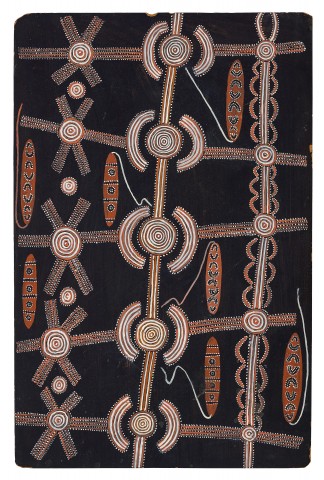UNTITLED (CEREMONY), 1972
ATTRIBUTED TO ANATJARI NO. III TJAKAMARRA
synthetic polymer powder paint on composition board
53.5 x 34.0 cm
Private collection, Tasmania, acquired by the vendor's father at Papunya in the early 1970s
Thence by descent
Private collection, Victoria
Deutscher and Hackett would like to thank John Kean and Luke Scholes for their assistance in cataloguing this work.
Described by Geoffrey Bardon as a man of wistful temperament, ‘slightly built with a particularly calm and gentle manner … very attentive and interested in what was going on but saying nothing.'1, Anatjari Tjakamarra was among the first of the Western Desert men to commence painting at Papunya in the Spring of 1971. Bardon recognised early that he was a painter of particular ability and by 1972, he had provided him with fine sable brushes that complemented his very fine line work. Anatjari occupied a particular place under the curved corrugated iron roof of the Nissen Hut that was the Men’s Painting Room – a place that ‘buzzed with excitement as men of high standing came together to paint a constellation of sites distributed across a broad band of country’2 and where Anatjari was able to observe the creative rush, individual styles and varied traditions that flourished in the early months of 1972.
Anatjari and his family were amongst the last of the desert dwellers to be moved off their lands by the ‘Pintupi Patrols’ and relocated to Papunya in mid-1966. These last arrivals became fringe dwellers, resistant to assimilation and consequently, the least acculturated of the Papunya settlement, renowned for their uninterrupted deep cultural links and ritual authority. With the resurgence of interest in traditional culture which occurred in the late 1960s, the new Pintupi arrivals began to receive recognition as senior figures within the Papunya community. According to historian Dick Kimber, Anatjari was a ritually very correct, conservative man, with a great concern for country and the key influences on his work related to secret-sacred men’s activities.’3
The current attributed work, Untitled (Ceremony), 1972, was most likely painted in the first months of 1972, and illustrates a men’s ceremony at an unidentified site in the artist’s homelands, far to the west of Papunya in the Gibson Desert, Western Australia. Painted on a matte black ground, five roundels representing ceremonial sites create a vertical axis through the centre of the painting with men shown seated at these sites. Space is created in the composition by the careful separation of sites and related objects, all of which are depicted in fine detail. Bullroarers and other objects of varying designs are distributed throughout the composition. The painting is balanced with different elements repeated in the work – a characteristic that highlights the influence of Anmatyerre artist, Kaapa Tjampitjinpa. Despite coming from different cultural backgrounds, Anatjari’s art was heavily influenced by Kaapa; as John Kean notes, ‘Anatjari adopted Kaapa’s sparse background and shared his capacity for graphic precision, punctilious attention to detail and both artists express a similar meticulous sensibility.’4 Untitled (Ceremony) relates to other paintings by the artist such as Ceremony, 1972, in the collection of the Museum and Art Gallery of the Northern Territory, Darwin, and Men’s Ceremony, 1971, formerly in the Laverty collection, Sydney
1. Bardon, G., and Bardon, J., Papunya, A Place made after the Story, The Miegunyah Press, Victoria, 2009, p. 71
2. Kean, J., ‘Framing Papunya Painting: Form, Style and Representation, 1971 – 72’ in Scholes, L. (ed.), Tjungunutja: From Having Come Together, Museum and Art Gallery of Northern Territory, Darwin, 2017, p. 192
3. Johnson, V., Lives of the Papunya Tula Artists, Alice Springs, IAD Press, 2008, p. 7
4. Kean, op. cit., p. 179
CRISPIN GUTTERIDGE
